- This topic has 98 replies, 3 voices, and was last updated 7 years, 4 months ago by
Giulio TiberinI .
-
AuthorPosts
-
27 April 2016 at 15:52 #7908
And and, exact, sorry, I meant to say that technique you used to bring the two curvatures…
Even my touching the edges… 9 May 2016 at 22:55 #7927
9 May 2016 at 22:55 #7927Reasoning of the secondary bending radii and the likes came to my mind a few things:
– Meanwhile, I rechecked the primary in which, It is having been worked digging toward the center, shortening ie the central reflections ( the kind that are on fire in the middle of the original sphere radius ), the focal length should be recalculated with respect to the sphere of departure or, rather, with respect to a machined parable with the classic method to 70% or lowering of the edge.
I therefore measured , the first fire of caustic hyperbolic ( the radius of curvature of the central zone ), the easiest to measure accurately, and the measurement is less than the original radius of curvature ( 1538 against poor 1544 )
Helping me then with CAD, I drew caustic reflection of the original sphere ( for reflections of parallel rays which is identical to that of the dish on the ROC), and I measured the draw difference between the center and periphery.For a mirror 300 mm spherical ( ROC=1544 mm ) the draft on the caustic “in ashes” and of 3,67 mm ( I remember that we are measuring the focus from infinity and not coinciding with the ROC source ), whereas in my mirror the center is drilled and the first zone “helpful” the reflection has a radius 35 mm, I measured a draw of this area of central 0.2 mm, therefore the center after parabolizzazione (the primary hyperbole is “quasi” a parable ) It has a fire 3,47 mm less than the original sphere in line with the measure “manual” carried out which must be divided by 2.
In conclusion, the focal distance of my mirror is 769 mm ( less than a few tenths ) against 772 “starting”.
For the purposes of hyperbolic shape of the primary, 3 mm focal length difference does not change the substance ( a parable would have been more damage because of the fixed value of K ). Entering into the new focal Software ( ROC for the center ) and maintaining the same measurements performed on drawdowns, what changes it is in fact the value of the conical constant which now has a value of from calculations -1.1154 versus -1.1120 previous one.
But this has a significant impact on the secondary hyperbolic which is reconfigured along with all the RC system, “playing” on the back-focus values and total focal length in order to obtain an almost equal to the previous system, that is compatible with the new focal Primary , the conical constant and the ROC of the secondary. The latter, however, will still change a few mm.
All this discussion to arrive at a question

We are sure that the radius of curvature of the spherical secondary ( in its center ) It remains as such until the end of hyperbolization ?
I do not think so, because if it is true that the convex working, the center ( nota bene, only the central point ! ) It is not changed with the processing to 70% , it is equally true that to work the concave caliber ( on which then we will build the convex ) instead we must also dig in the middle
It does not change if we decide to work the caliber of working the periphery without changing the center, as doing so we create a more hyperbole “open” with respect to the sphere, then on the convex then we will have to dig inevitably center…
Would not it be better to pre-calculate the ROC's caliber iperbolizzato ( with processing to 70% ) and take this value as a final radius of curvature of the convex ?
another question :
we are sure that a focal ratio so driven with a constant conical “pretty tough” is manageable with a tool to full diameter changed only in the area 0,707 ? Here I have my doubts, I think at best you will have to do a whole lot’ of corrections, but I do not see how to do them with a tool so configured..
in the meantime, for safety, I pulled out my friends sub-diameter and have adapted them to the gauge…
 11 May 2016 at 10:05 #7931
11 May 2016 at 10:05 #7931Hi Massimo, I could not answer…iperbolizzare clearly working towards the center and working outward or 70% also it allows to obtain the desired conic constant, but how well you say the three cases at the end will present slightly different focal lengths and it is here that my preparation is about an obstacle, in the sense that I have the tools and preparation to evaluate these small differences on the optical yield of the final tool.
The differences may be negligible or perhaps maybe not, not I have no idea.
“Would not it be better to pre-calculate the ROC's caliber iperbolizzato ( with processing to 70% ) and take this value as a final radius of curvature of the convex ?”
It could be a good idea… 11 May 2016 at 13:31 #7932
11 May 2016 at 13:31 #7932And, the problem is just that, in the sense that if we get the desired conic constant, at the moment to obtain it modify the ROC of the secondary, the right conic constant is not what we got…
How all this affects the system optical goodness ? let's check it in case of my RC System:
-meanwhile we know ( simulating with software to foucault ) that the variation of the ROC of the gauge with respect to the original sphere for K = -5.13 ( Overall draw with the mobile source ) it's about 8,5 mm, enormity of a mirror from 115 mm !
 so we assume that working on 70% we'll have ( eye… ) 5 mm variation on the center and the remaining on the edge, but it could also be otherwise, This depends on our workmanship.
so we assume that working on 70% we'll have ( eye… ) 5 mm variation on the center and the remaining on the edge, but it could also be otherwise, This depends on our workmanship.-we see then how would the theoretical spot for a point source on the RC system with the correct parameters for a field 0.4 degrees equivalent to 16 mm image focal plane.
Let's see using Atmos:
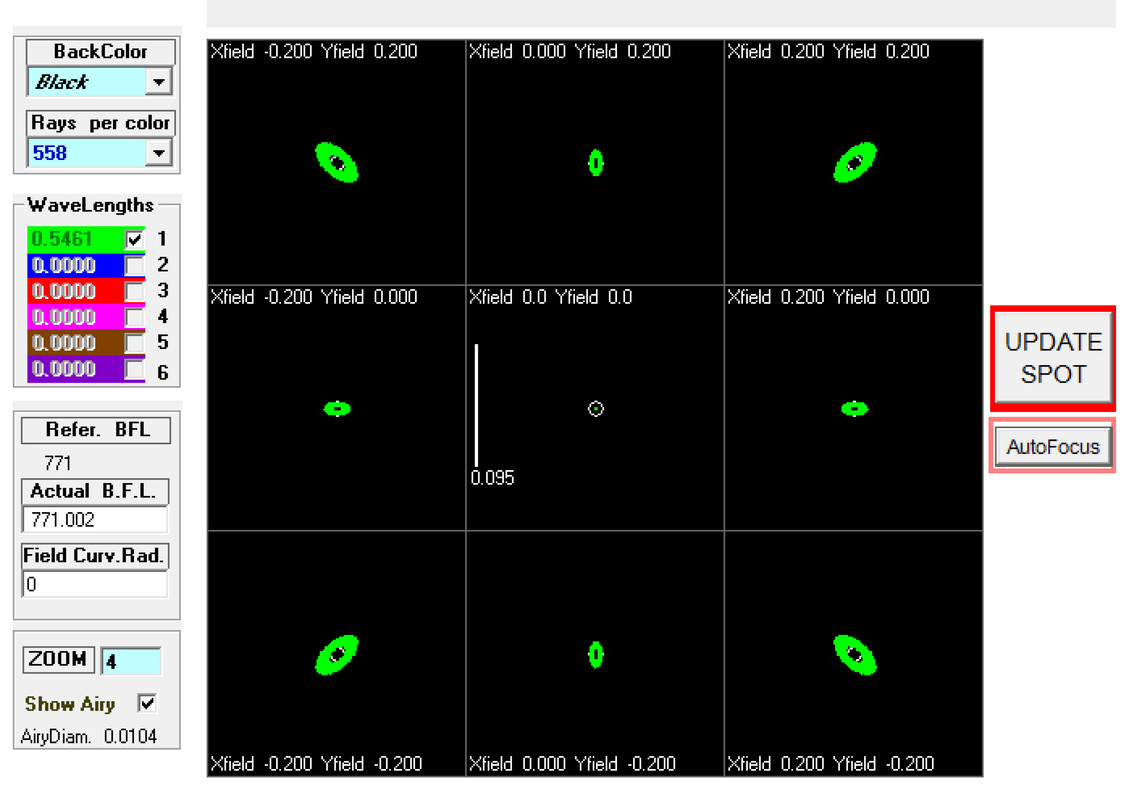
this is the “field helpful”, atmos calculated by focusing on the central point of the field , in the sense that although the system “coma free” beyond this field value other extra-axial aberrations ( distortion and astigmatism ) begin to be important.
The central circle is the Airy disk which in this case measure 10 microns.practically, to further improve the image on the focal plane is replaced by a “makeup”: one renounces perfect focus at the center and focuses on an intermediate point of the field since the main problem for a RC is the curvature of field. In the image below the fire has an offset of -2 tenths of a mm ( circa )
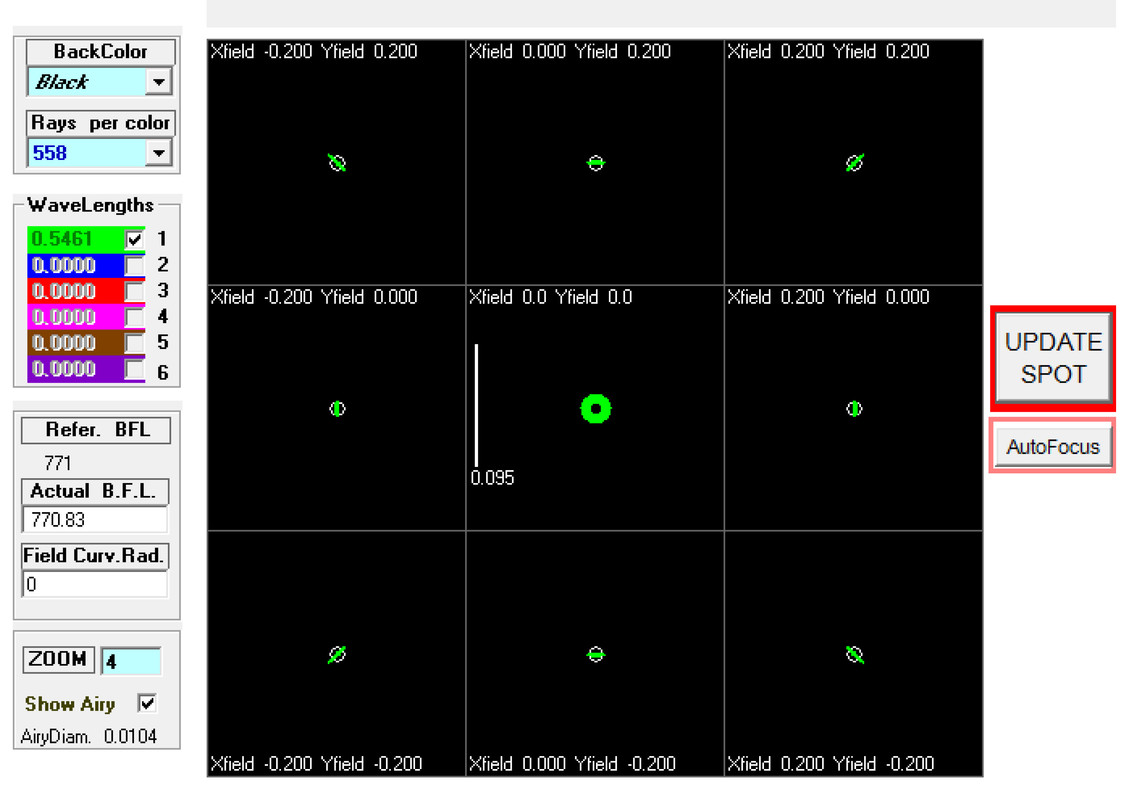
As shown, the central spot now has a size just greater than the Airy disk, while the rest of the field is corrected within a radius of 0.2 degrees ( 16 mm diametro )
This with the correct parameters. Now let's try to replace in the secondary the new ( hypothesized ) curvature to the center, of 5 mm lower but with identical conical constant, obtained from the processing and measurement of the caliber.
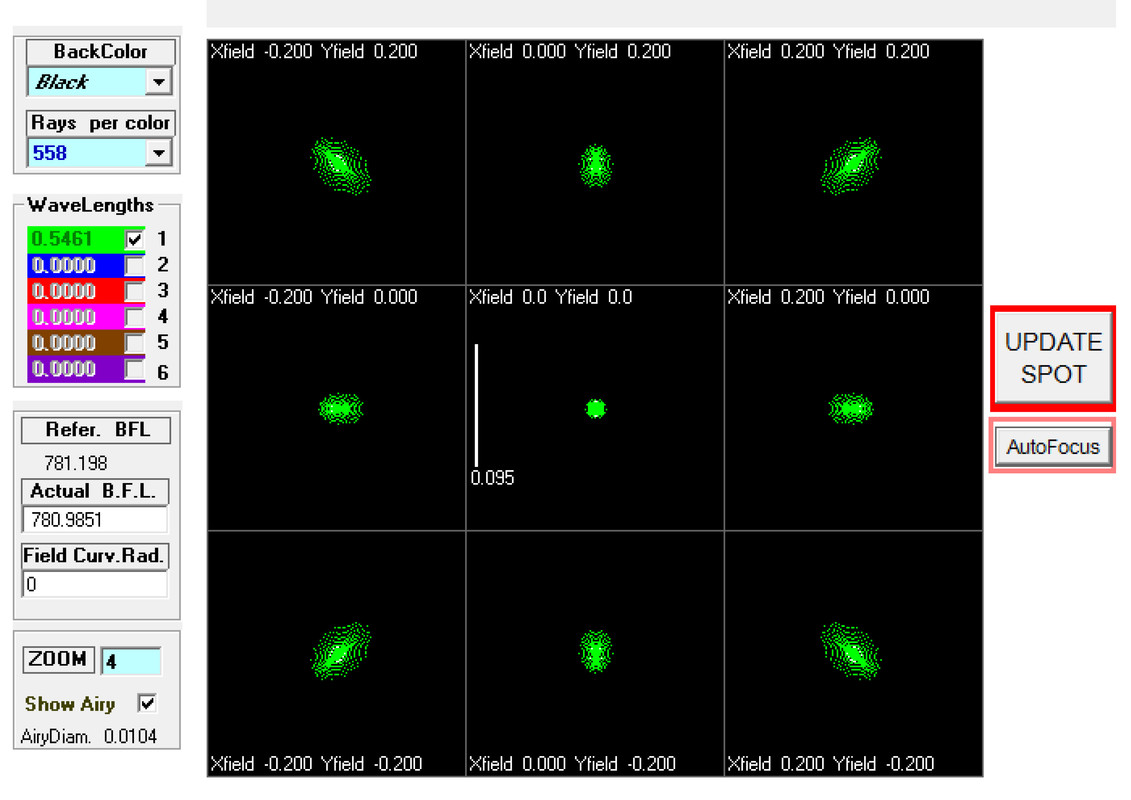
Meanwhile, we have that the resulting focal length is increased by 3 cm ! However, the new focal plane ( automatically calculated by atmos ) no one correct spot even in the middle, being higher than the Airy disk.
Let's try to run the “makeup” and search for the best visual fire: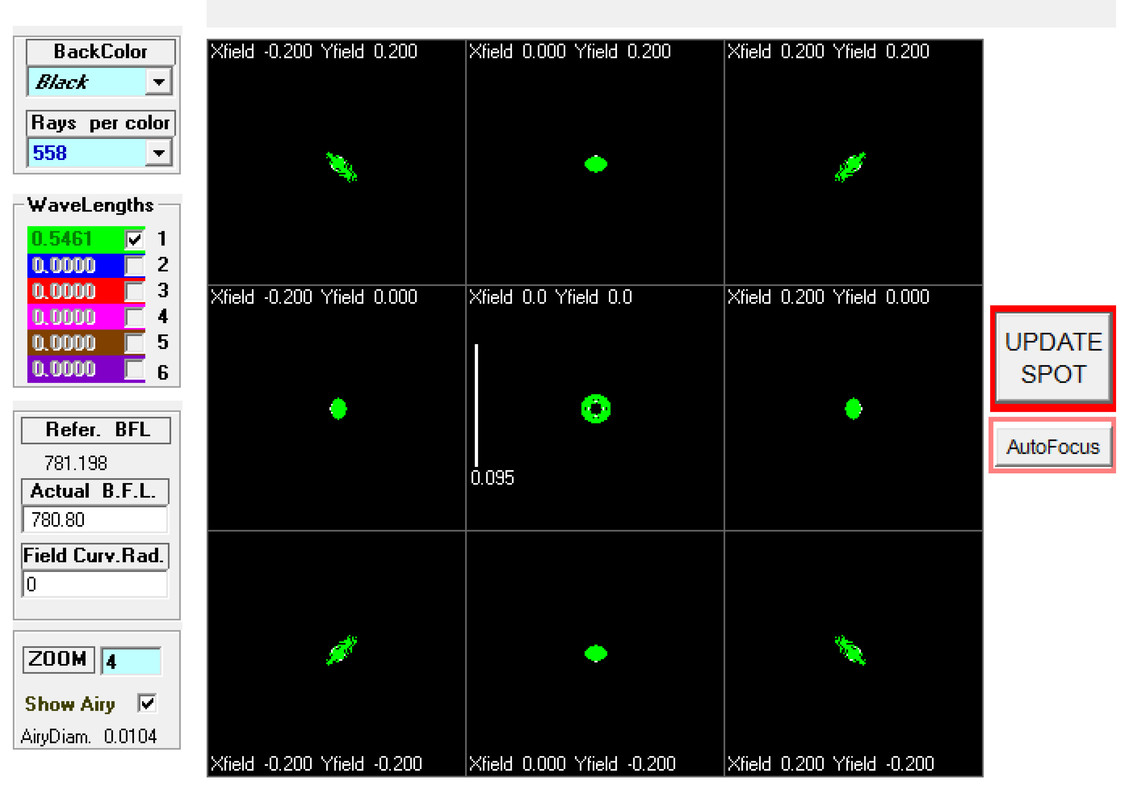
Also by doing so, across the field the stellar image would be larger than the size of the Airy disk. The problem is therefore that for this new overall focal distance obtained by varying the ROC of the secondary , it would take several conic constants for the secondary and also for the primary ( to a lesser extent ).
As ultimately, It is interesting to see the image provided by a Newton diameter and equivalent focal ( F7.8, Newton with a very good coma in the minimum terms ! ) on the same angle of field.
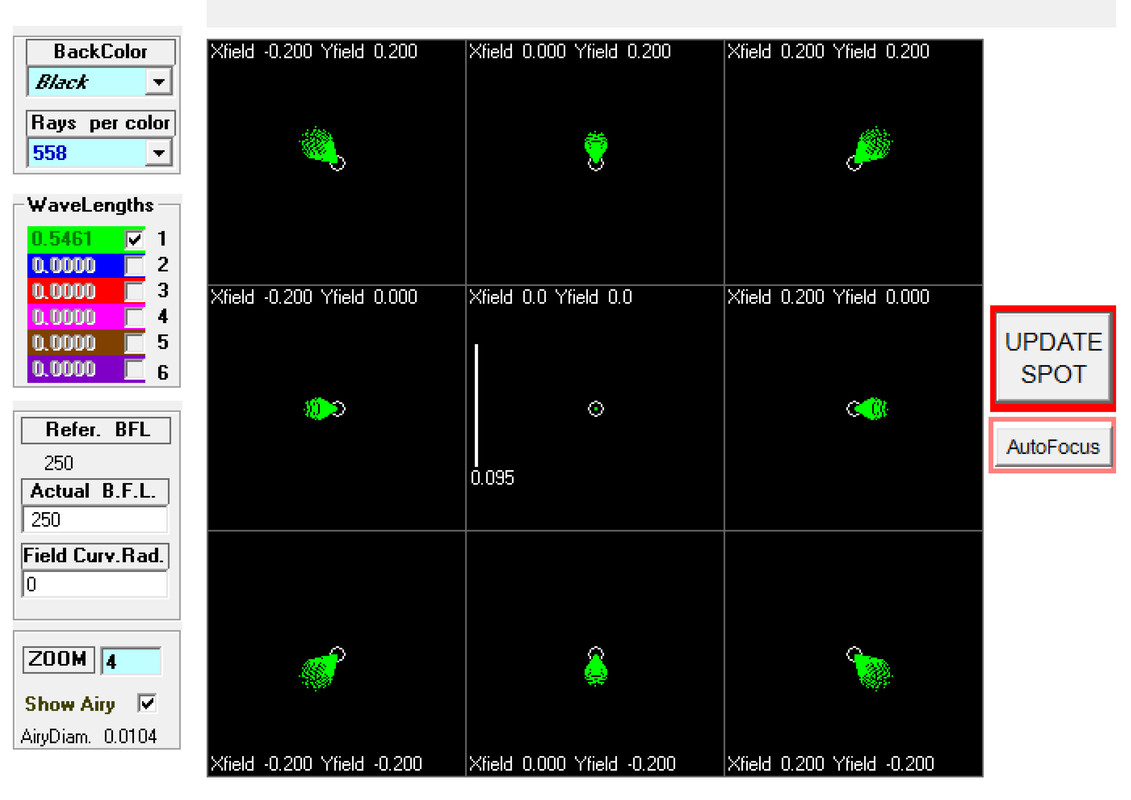 12 May 2016 at 12:24 #7937
12 May 2016 at 12:24 #7937Interesting these graphics…

But sorry Massimo, but then it would not be enough to stop with the polishing to a sphere with a radius of curvature of 8,5 mm longer than the final one of the hyperbola. Then during the hyperbolization you should be able to remove those 8,5 mm thus arriving at ROC and K desired.12 May 2016 at 13:51 #7941I thought so, but I'm not sure…
Admitting that it manages to arrive at the correct form of the hyperbola on the gauge with working from the center, it is still dig 3 hundredths of mm with pitch and cerium oxide on the caliber and equally on the convex, a long and tiring work !The hyperbole than the parable “flattens” lot in the suburbs, for this I believe that it is entered to the processing 70%, because it is much faster to create such a marked difference in curvature flattening the edge and at the same time digging the center ( obviously on the gauge ), the material to be removed is much smaller.
I think the cheapest solution is the one that you have also indicated, but calculated by the machining area 0.707. Simulating this process one can obtain the new radius of curvature for the center and builds the ball with ROC longer than the value found.
All this should then be checked with the gauge before you start working the convex. Once assured of the central ROC hyperbolic caliber, It occurs the value of K ( if anything, it just enough Remodeling ) and optimize ( if any were needed ) the optical schema with the value found, playing on back-focus parameters and distance between the mirrors which may vary very little of this point but allow to have ( at least in theory ) an absolutely correct optical scheme.
13 May 2016 at 22:40 #7943Meanwhile I went ahead by modifying the ROC of the secondary in order to better adapt it to the primary, since he also, as you said, It has a shorter focus than I thought…
In practice, the system remains dimensionally identical in the structure of the telescope, changing the radii of curvature and the conic constant, slightly but still different.
So after shortening of some mm caliber of the ROC, I rebuilt the new ball and, as I was, I gave him a “sistematina” to the edge ribattutto ( In fact there's still a little bit, but it is always better than before ! )
( In fact there's still a little bit, but it is always better than before ! )Then it was the turn of the convex shortened in Roc and rebuilt in the sphere.
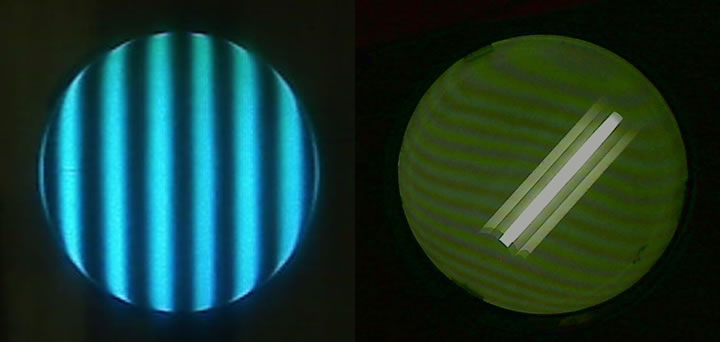
Mirco, I see only two rings, the first beautiful wide in the middle and the second thinnest edge. I can not do because of the images in my homemade method for interferometry ( I have to do this blessed tester
 ) rings when they are less than three become too evanescent, one can see but you can not photograph them.
) rings when they are less than three become too evanescent, one can see but you can not photograph them.With a slight tilt can see only a few fringes, but even here the visibility is proportional to the number of fringes. Less and less are seen ! Playing with the contrast , the brightness and colors, you can feel something more, not much but I think that it is enough for a first evaluation of the.
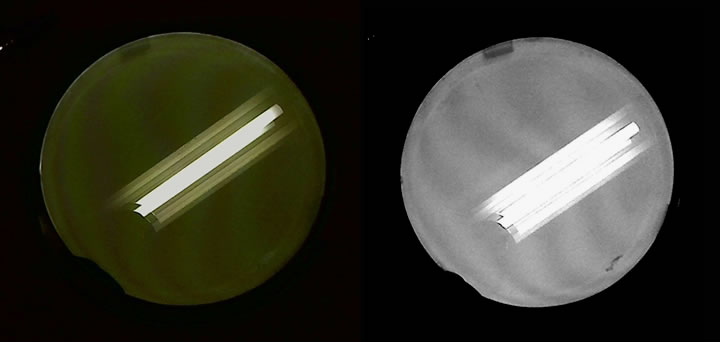
It seems to me that the spokes are similar, with little difference. If you play badly, Now the board is countered on the convex… Oh well, We will arrange that too

 15 May 2016 at 11:42 #7946
15 May 2016 at 11:42 #7946I find totally clueless on.
Beautiful homemade interferometer!14 June 2016 at 4:35 #7999A short time available for scratching, What is needed is a lot more…

Anyway, Meanwhile the concave caliber is an advanced stage of hyperbolization, I should be at a constant taper of about -3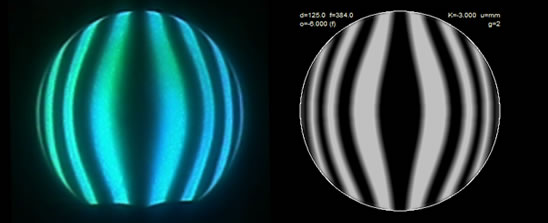
The convex instead is back with the processing, but from what I see it is quite complicated to create and maintain proper form. I do not think that will be enough to change Area patina 0.707, also because I do not see how you can make corrections or touch-ups using only this kind of tool, I think it would take more than one, Similar as realization but with a different extension of the annuli.
Even the caliber is proving more difficult than expected, with the increase of the conical constant, and then the curvature, The center tends to stay longer “dish” with respect to the due, using the full diameter ( he changed to the area 0.707 ).
More than once I had to correct with a tool to 50% to put on the form “right path”…I fear that the hyperbole with the technical 70%, though ( in theory ) faster, both more complicated and more difficult to manage compared to the deepening central, mah.. we'll see along the way it will agree to do
 14 June 2016 at 23:36 #8000
14 June 2016 at 23:36 #8000I do not know the problems…But the shape is realized already beautiful and identical to the simulation.
 16 June 2016 at 12:05 #8004
16 June 2016 at 12:05 #8004Hi Massimo, wow already at K = -3, you're going ships and with excellent results, among other things…

And, I also think that with the full diameter is difficult to manage such a deformed surface…I know that you also use the sub-diameters, I do not think at all that this will scare, view of the now great experience you have acquired… 17 June 2016 at 3:49 #8010
17 June 2016 at 3:49 #8010It's getting cold, we are -4 !



Too good Giulio, actually there are the flaws and you will see all, anyway thanks for the support

So will be the case starting the measurements with Foucault ( He will be happy with our friend Mike ! ) before combining some frittata
Mirco, I agree, a surface so “thrust” you can not deal with the full, and it goes on, the more it becomes difficult to maintain a next figure to the hyperbolic even with the sub-diameter. But the “bello” It is yet to come, from what little I've seen so far, machining of the convex is even more complicated, especially with sub-diameter !
14 August 2016 at 17:41 #8146Finally in this period, I managed to find some free day to complete at least the concave caliber and bring it to the desired shape

I must say that going ahead with the deepening processing becomes difficult, I found it very difficult to manage the form after overcoming the value of K = -5. The final corrections have given me “hard time” more than I expected, also the small sub-diameter are struggling to work without producing side effects.
Perhaps the tools that best fit these processes “pushed” They are those made with a circular crown patina that works only in the vicinity of the diameter to be corrected. From what I've seen, These tools give good results, especially with the convex, where the sub-diameter are virtually unusable…
Good help is instead come from software “Virtual Couder Screen”, with whom I could do the Foucault test sessions in a very fast and precise.
The beauty of this software is that it allows you to quantify the difference of the light gradient between two opposite windows of the mask Couder (virtual ) , When this difference is zero, you're in the point to be measured. In practice, it arrives at the same result of the visual evaluation, I did not notice appreciable differences, just getting there is a fraction of the time required to measure “eye”. Besides, you can change the mask instantly without touching the setup, and switch instantly from the test to 5 zones to that with 7 zones, 9 zones etc.…
With this system, each of the Foucault test session lasted a maximum 5 minutes.Anyway, until the last corrections I have worked almost exclusively with 5 zones, because it becomes difficult to think of intervening with corrections when the area of the extension is less than a centimeter !
This is the final report for the test of foucault 5 zones, with the exclusion of the central area up to the radius 15 mm.
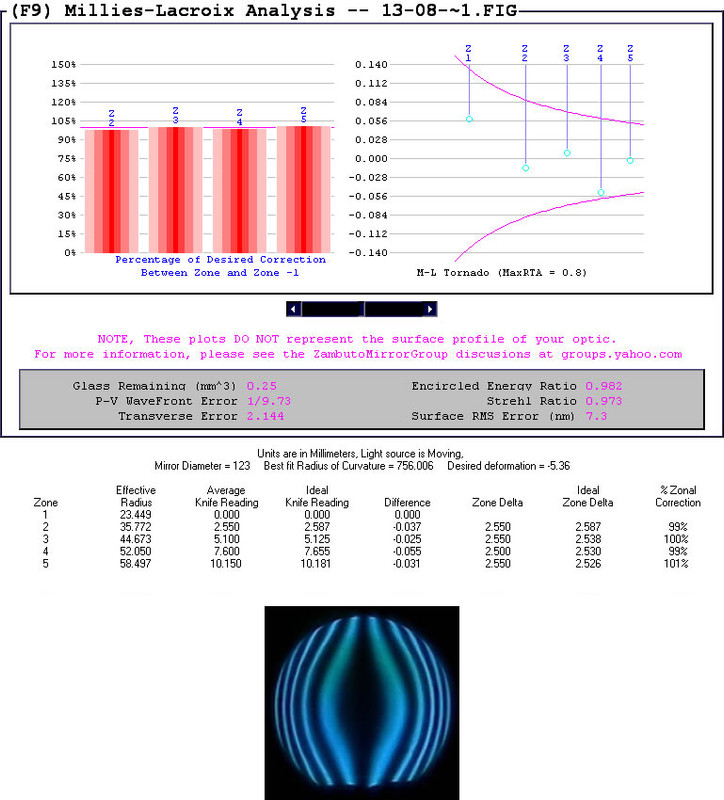
repeated test 7 zones
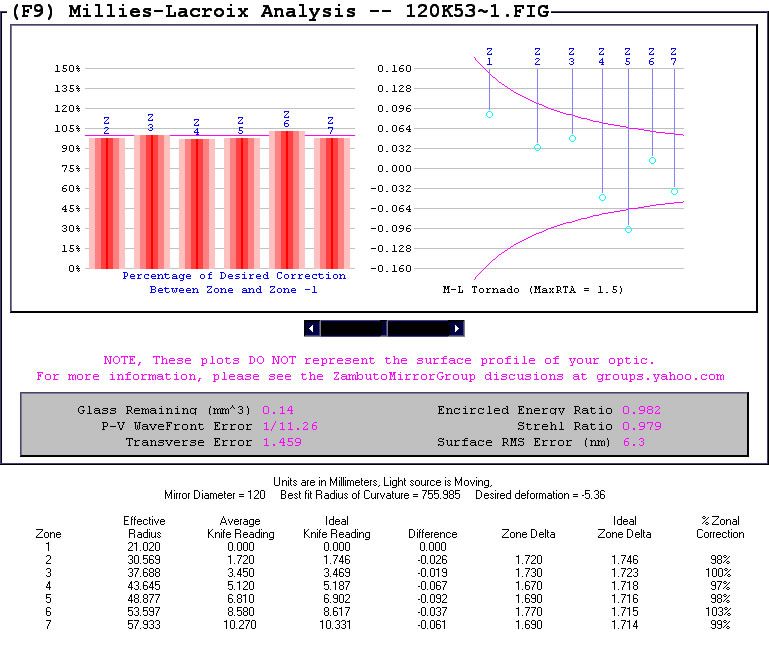
By evaluating more areas, the shape is less correct, but to me that's fine because we are close to the value of the constant conical design ( K=-5.36 ). In fact, the “best fit K” It indicates a value of -5.358.
So I think it is not convenient to insist over. There is much to say about work, the method I have followed ( digging the center ) it is not recommended and certainly not the best, with these deformations one ends to dig a hole in the center that alters the very central curvature radius, doing “jump” All parameters of the Cassegrain related project.
In my case it's not a big problem, the telescope still does not exist ( apart “prototype” wood without cell floating points and with a secondary support “the priest alive”

 ) there is only the primary and is soon to optimize backfocus and other parameters as a function of the new radius of curvature of the secondary which, meantime, It rose from 772 mm to initial 756 mm end hyperbole ( only the central zone of course ! )
) there is only the primary and is soon to optimize backfocus and other parameters as a function of the new radius of curvature of the secondary which, meantime, It rose from 772 mm to initial 756 mm end hyperbole ( only the central zone of course ! ) I think the solution is to use the classic technique ( indicated by all authors ) to a 70%, It is much faster and are not likely to deform the mirror exceedingly, though, I think it's definitely more difficult to handle during the corrections.
Now we end this blessed convex
 , which it is still at a constant conical -2 or so…14 August 2016 at 18:43 #8148
, which it is still at a constant conical -2 or so…14 August 2016 at 18:43 #8148Great job Massimo!
Of course it's not exactly a walk! Luckily a nice part of the work you've already completed.
(Would you be able to estimate “spannometricamente” working hours that separate you from the end of the tunnel)?14 August 2016 at 22:02 #8149Unfortunately not, I have no idea…I believe it depends a lot on luck to do the right thing at the right time, if so, free processing mistakes could earn 1 or 1,5 tenths of a conic constant in session from 15-20 minutes, in twenty to thirty sessions you could bridge the distance that separates me from arrival, then 7:00 to 10:00 actual hours may be sufficient, I do not think it's realistic to think in these terms, it is difficult to work the convex ( at least for me… ).
The main problem I think is due to the fact that any work we do on the convex surface, realize, however, a concave correction, since we can only dig, then go in the direction opposite to that of the surface, which means “come back” if we go to the slightest touch of the surface that are not to be touched…
So the easiest thing that can happen is that while trying to increase the curvature of the result tells us that instead we flattened or worse off we went to the central area ( the center on the convex is the equivalent of the edge on the concave, just one and to restore them to the correct figure error must remove glass from the entire remaining surface ), so you often have to go back to some previous step and start over.
So I can not tell how long it takes for “exit from the tunnel”, definitely the third or fourth Cassegrain build, I shall be more precise

-
AuthorPosts
- You must be logged in to reply to this topic.